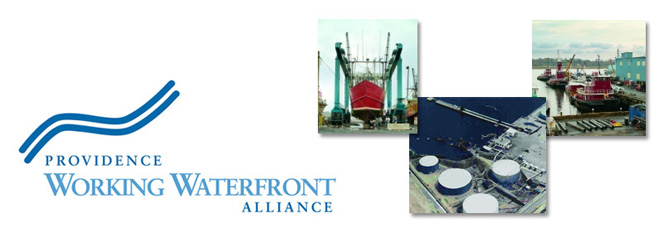Planning Study Recommends Flexible Industrial Zoning for Providence’s Working Waterfront
September 24th, 2008
Download the complete planning study.
To build on the extensive feedback from port experts and the public at June’s Waterfront Charrette, the Providence Working Waterfront Alliance commissioned the planning specialists at the Horsley Witten Group to develop planning and zoning recommendations to both preserve existing waterfront jobs AND provide a flexible platform for future economic growth.
Planning Study Conclusions:
- The Port of Providence is a unique regional resource due to its recently dredged 40-ft deep-water channel, oil storage capacity, and significant number of high paying blue collar jobs.
- The potential for residential or hotel uses in waterfront industrial areas creates a sense of unpredictability that serves as a disincentive for new industrial development or the expansion of existing operations.
- Working waterfront and industrial business along the Allens Avenue corridor are physically and visually isolated from adjacent neighborhoods.
- Experts from other ports have emphasized the need to definitively separate residential and hotel uses from working waterfront industrial areas.
- Language in the Interim Comprehensive Plan attempting to balance the presence of residential, hotel, commercial, and heavy industrial uses would create a counter-productive situation.
Suggested Amendments to the Interim Comprehensive Plan:
1. Extending the existing Jobs District, which prohibits all residential and hotel uses, from ProvPort northward to include the entire working waterfront and industrial area along Allens Avenue.
2. Changing the Proposed Land Use Map’s current “Waterfront Mixed Use/General” area to a “Waterfront Mixed Use/Industrial” area that prohibits residential and hotel uses, but maintains flexibility by encouraging the establishment of criteria for the inclusion of lower intensity non-residential uses.
Suggested Amendments to the Providence Zoning Ordinance:
Create an Industrial/Manufacturing Overlay District (IMOD):
This overlay zone is intended to provide heightened protection to those areas in the City where significant levels of commercial, manufacturing, or industrial activities take place. These areas represent unusual local and regional economic opportunities for high intensity uses due to established land use patterns and/or proximity to transportation infrastructure. Regulations imposed on these areas will be designed to facilitate new development, redevelopment and expansion of heavy commercial, manufacturing and industrial uses by limiting and, in some cases, eliminating the potential for incompatible uses.
Modeled after Baltimore’s successful Maritime Industrial Zoning Overlay District, the IMOD would protect Providence working waterfront and industrial businesses from incompatible residential and hotel uses. While restrictive, the IMOD would allow for certain non-residential uses so long as they follow development criteria designed to minimize interference with existing industrial businesses.
Download the complete planning study.

